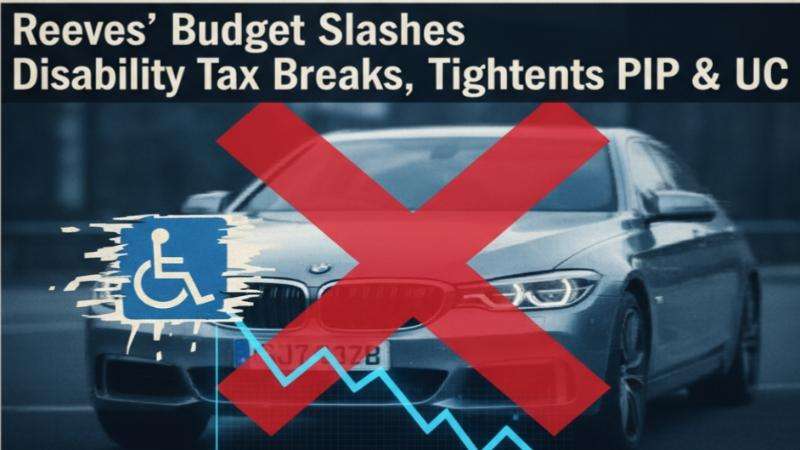UK Benefit Shake-Up: Chancellor Confirms Welfare 'Untouched' No More as £1bn Disability Car Tax Breaks Face Axing- Chancellor Rachel Reeves has delivered a powerful warning that the UK's welfare system cannot be left "untouched" as the government races to find savings ahead of the November Budget. The move signals a major and controversial shake-up of disability and health benefits, including a reported plan to axe up to £1 billion in tax breaks for the popular Motability scheme, Daily Dazzling Dawn understands.
Speaking after an attempt to push through disability benefit cuts earlier this year was abandoned, the Chancellor stressed the need for reform to control spiralling costs and avoid higher taxes on the public. "We can't leave welfare untouched," Reeves said, arguing that increased welfare spending would ultimately take money away from the NHS and schools.
Key Proposed Changes & Reforms:The government's plan focuses on "reforming" the system to encourage work and target support, with significant financial implications for both current and future claimants.
1. Motability Scheme Tax Breaks Under Threat
The Cut: The Treasury is reportedly considering ending the VAT and insurance premium tax exemptions for cars leased under the Motability scheme, which could save up to £1 billion annually.
Targeting Luxury: Another change being considered is the removal of luxury brands like BMW and Mercedes from the scheme, which currently account for about 5% of the 800,000 Motability cars. This is reportedly about "fairness" as much as cost-saving.
Impact: Removing these exemptions would add significant costs to the lease, potentially making Motability cars more expensive for claimants who rely on them for independence.
2. Universal Credit (UC) Health Element Reductions-
Major changes to the health element of Universal Credit are already set for the coming years:
New Claimants (From April 2026): The UC health element (Limited Capability for Work and Work-Related Activity will be significantly reduced to £50} a week (from the current rate of approximately £97 a week and then frozen until 2029/30.
Existing Claimants: The rate for current recipients will be frozen in cash terms at the 2025/26 rate £97 a week until 2029/30, representing a real-terms cut.
Standard Allowance Boost: To mitigate the impact, the UC Standard Allowance is set to increase above inflation over four financial years, reaching around £106 per week for a single person aged 25 or over by 2029/30.
3. Personal Independence Payment (PIP) Tightening
The government plans to restrict eligibility for PIP, designed to help with the extra costs of long-term health conditions or disability:
New Requirement (From November 2026): Claimants will need to score a minimum of 4 points on at least one daily living activity to qualify for the daily living component. This is designed to focus support on those with the most severe conditions and is expected to result in an average loss of \text{£4,500} per year for between 800,000 and 1.3 million disabled people.
Daily Dazzling Dawn Analysis: What Else May Come Soon?
The proposed reforms mark a significant shift towards fiscal consolidation through welfare spending, and the pressure to fill the estimated \text{£50} billion fiscal "black hole" suggests these initial changes may be only the beginning.
Our analysis suggests two main areas where the Chancellor may seek further changes:
Attendance Allowance (AA) Reform: AA is a non-means-tested benefit for disabled people over state pension age. A structural reform, potentially integrating it into a new, single "disability payment" or applying tighter eligibility criteria similar to the proposed \text{PIP} changes, could yield substantial long-term savings. The sheer number of claimants and the relatively ring-fenced nature of pensioner benefits make this a politically difficult but fiscally attractive target.
Housing Benefit/Local Housing Allowance (LHA) Cap: While often linked to housing policy, controlling the \text{LHA} rates (which determine the maximum Housing Benefit/UC housing element) is a direct lever on the welfare bill. Currently, \text{LHA} is linked to the 30th percentile of local market rents. Freezing the \text{LHA} again, or resetting the link to a lower percentile in high-cost areas, would immediately slow the growth of rental support spending, transferring a portion of the housing cost burden to claimants.
The overarching strategy is clear: rebalance support away from the "health element" and towards the "standard allowance" of Universal Credit, while tightening the gateway to disability payments, all in the name of both savings and incentivising work.








.svg)

_2.jpg)
_3.jpg)